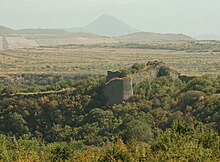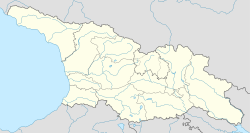
Back Самшвилде Bashkir Sàmxvilde Catalan Σάμσβιλντε Greek Samshvilde Spanish سامشویلده Persian Samshvilde French Սամշվիլդե Armenian სამშვილდე Georgian Sanxevilde Portuguese Самшвилде Russian
სამშვილდე | |
 Ruins of the Samshvilde citadel | |
| Location | Tetritsqaro Municipality, Kvemo Kartli, Georgia |
|---|---|
| Coordinates | 41°30′26″N 44°30′20″E / 41.50722°N 44.50556°E |
| Type | Settlement |
| Length | 2.5 m (8 ft 2 in) |
| Width | 0.4 km (0.25 mi) |
| History | |
| Periods | Early Bronze Age to Early Modern |
Samshvilde (Georgian: სამშვილდე, [samʃʷilde]) is a ruined fortified city and archaeological site in Georgia, in the country's south, near the homonymous modern-day village in the Tetritsqaro Municipality, Kvemo Kartli region. The ruins of the city, mostly medieval structures, stretch for a distance of 2.5 km in length and 400 metres (1,300 ft) in width in the Khrami river valley.[1] Some of the most recognizable monuments are the Samshvilde Sioni church and a citadel erected on a rocky river promontory.
Samshvilde features in the medieval Georgian annals as one of the oldest cities of ancient Kartli, dating back to the 3rd century BC. In the Middle Ages, it was an important stronghold as well as a lively commercial and industrial city. Samshvilde changed hands several times. At the end of the 10th century, it became capital of the Armenian kings of Tashir-Dzoraget and was incorporated in the Kingdom of Georgia in 1064. From the mid-13th century on, as fortunes of the medieval Georgian monarchy faded, Samshvilde went into decline and was reduced to a peripheral military outpost. By the end of the 18th century, it was in ruins.
- ^ Gamkrelidze et al. 2013, p. 440.
